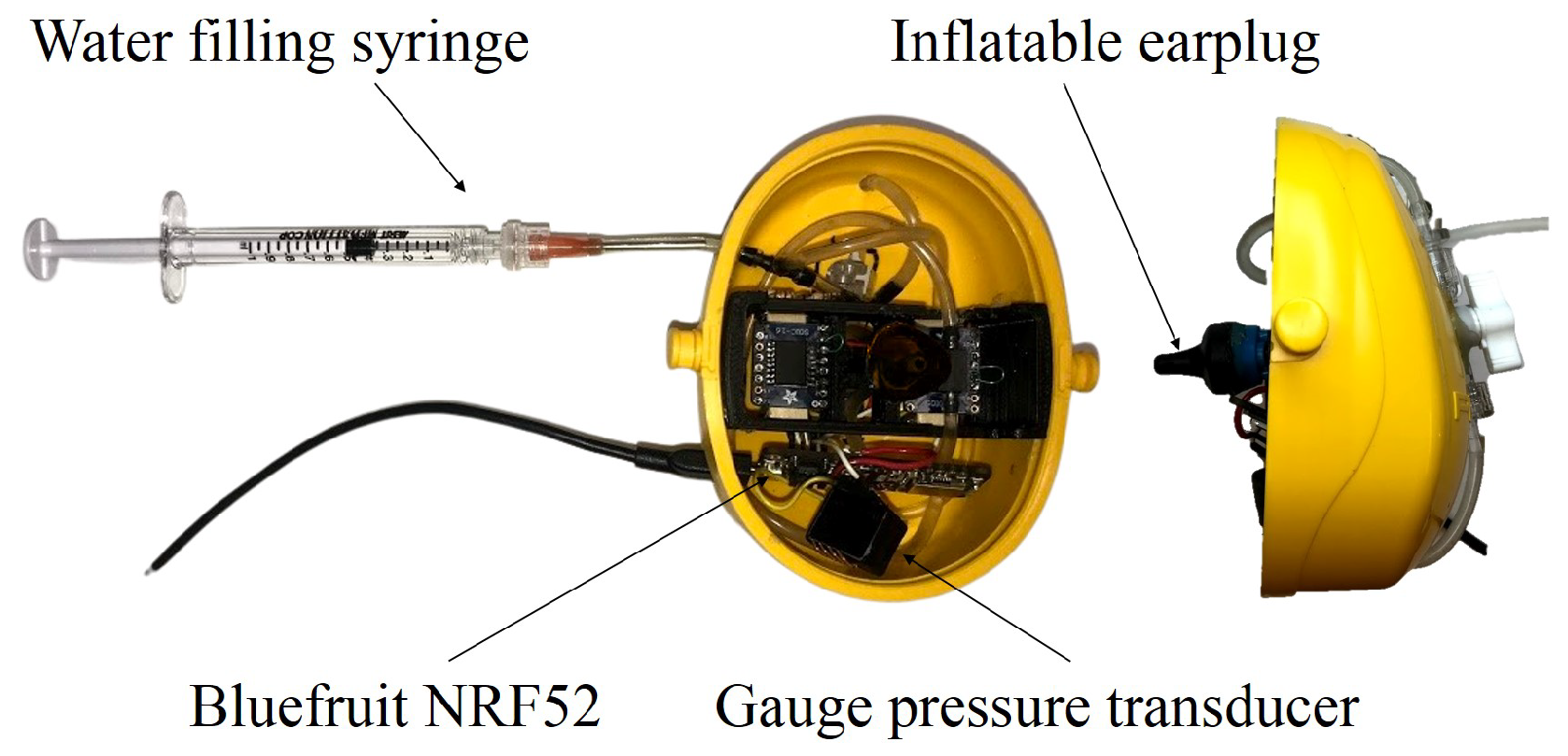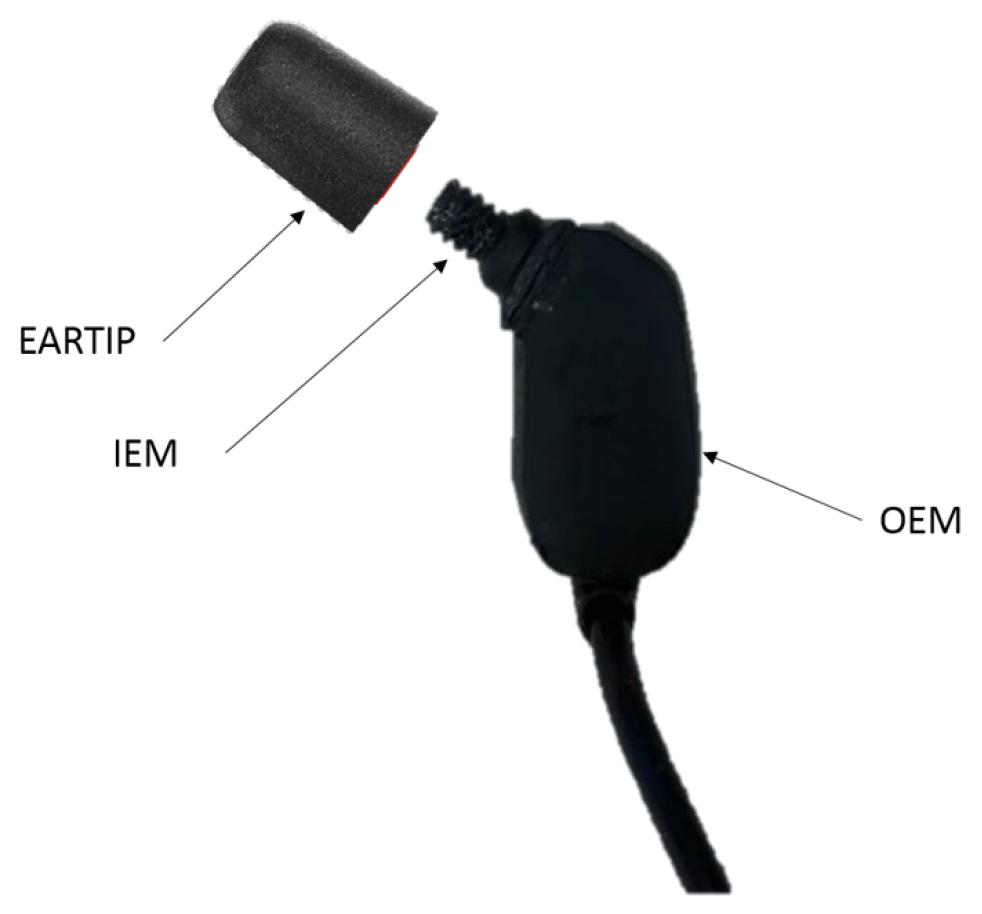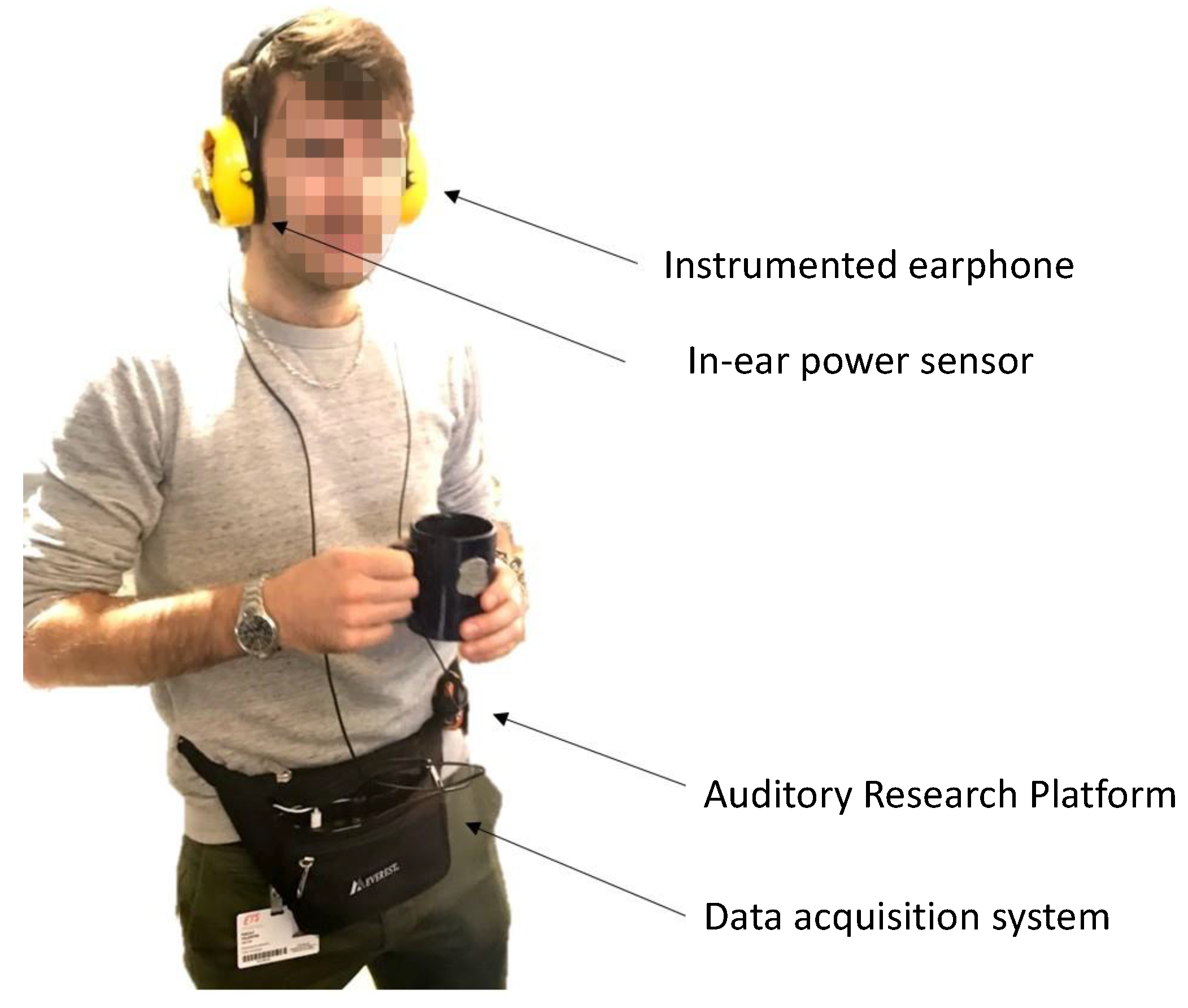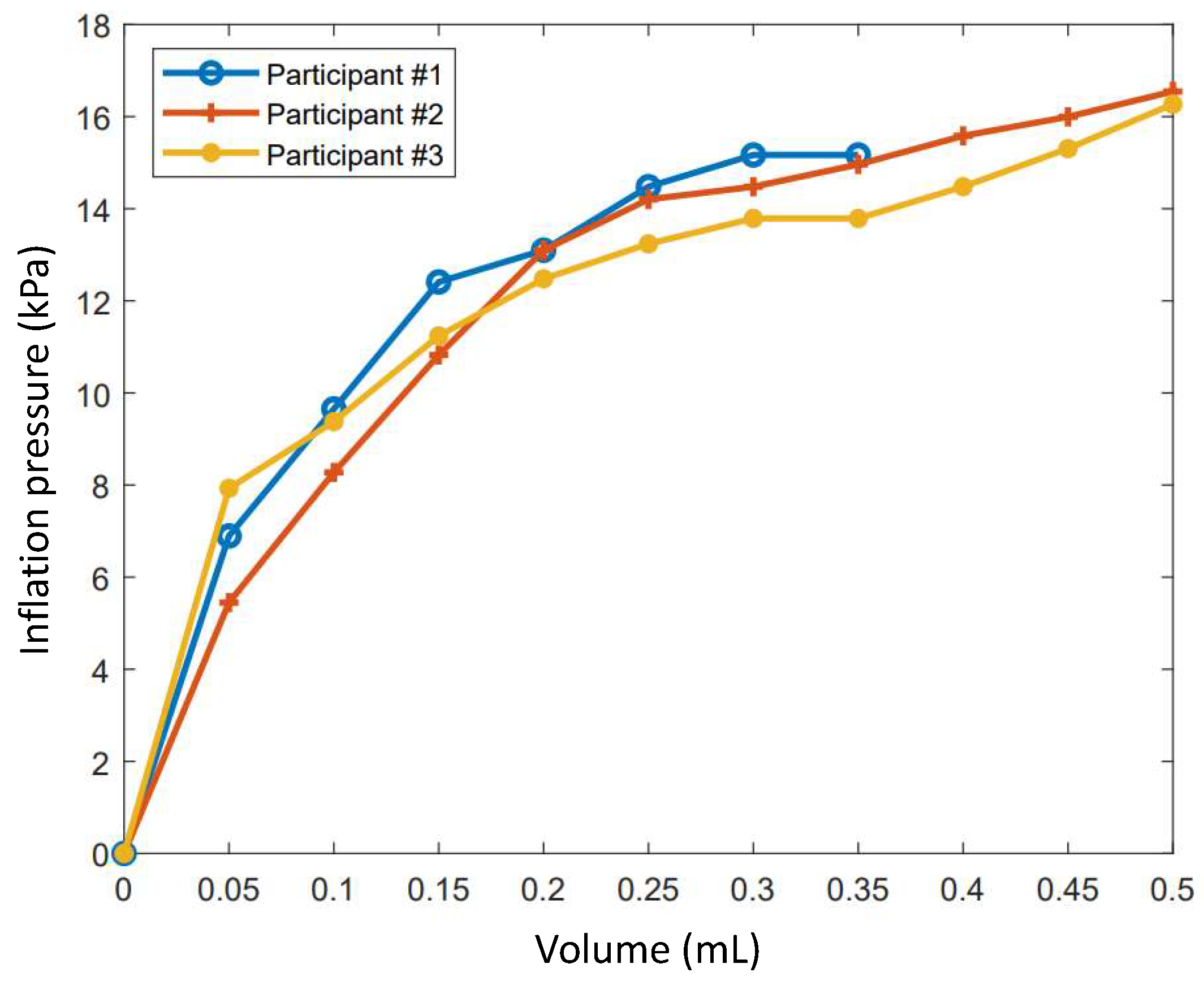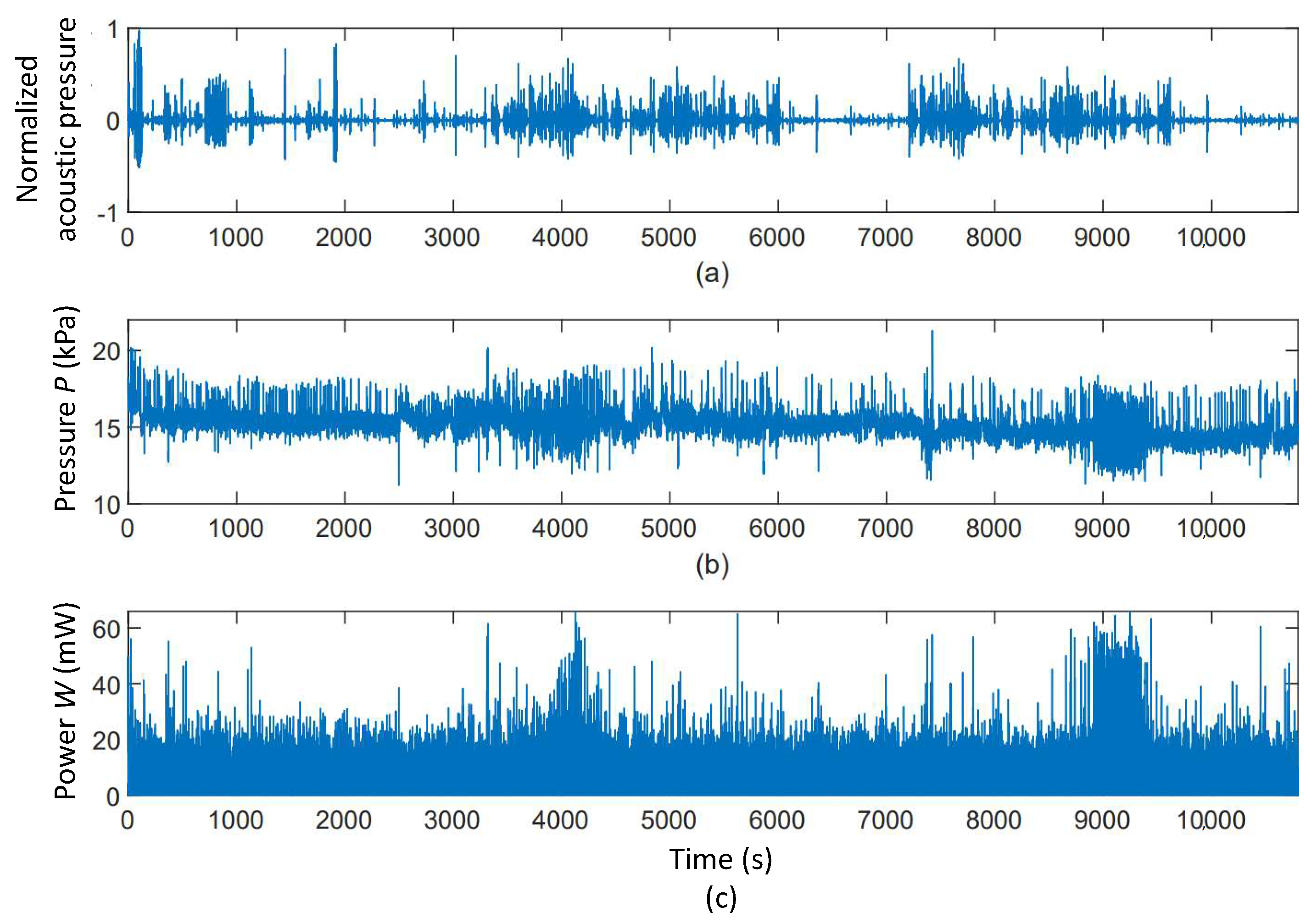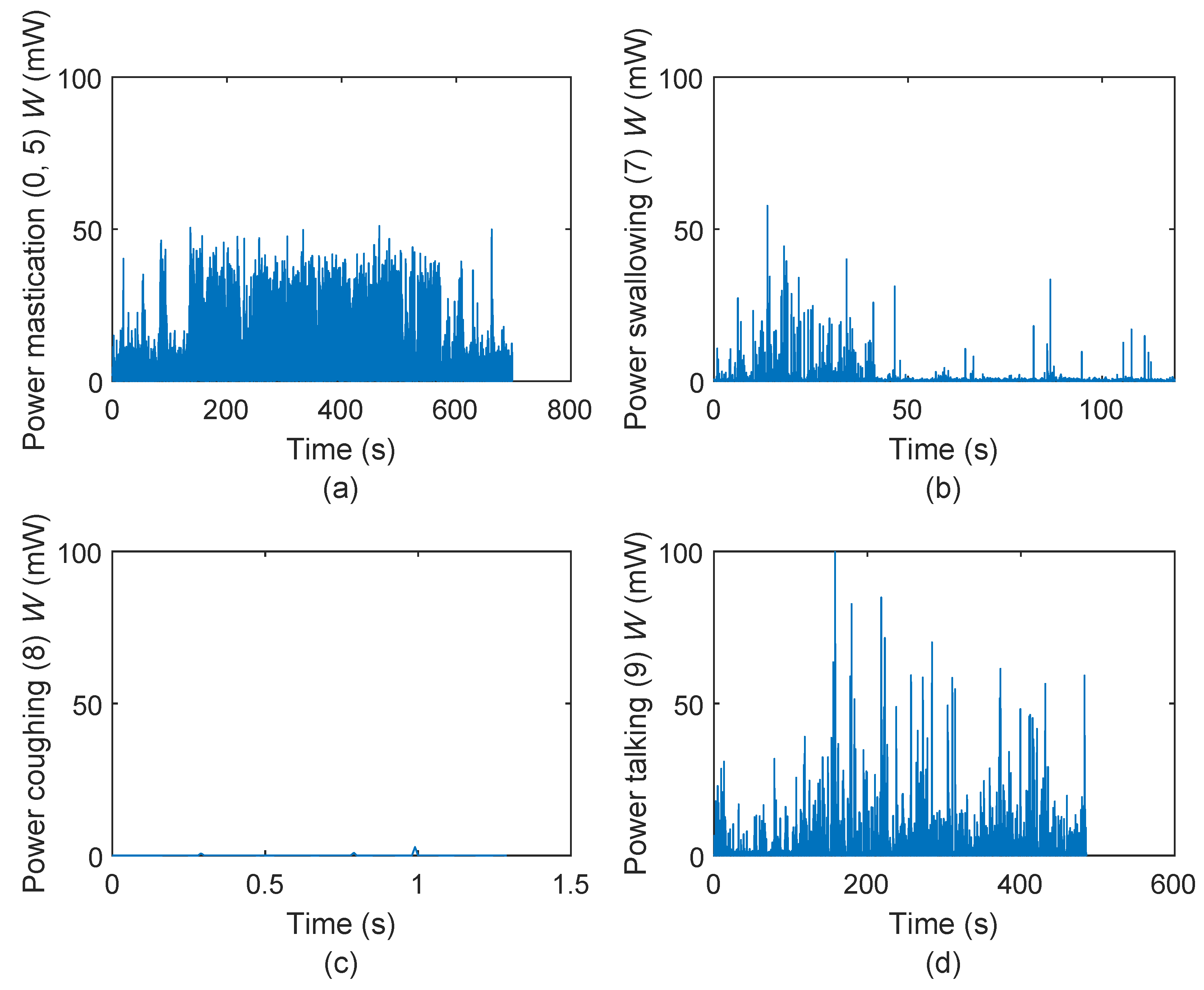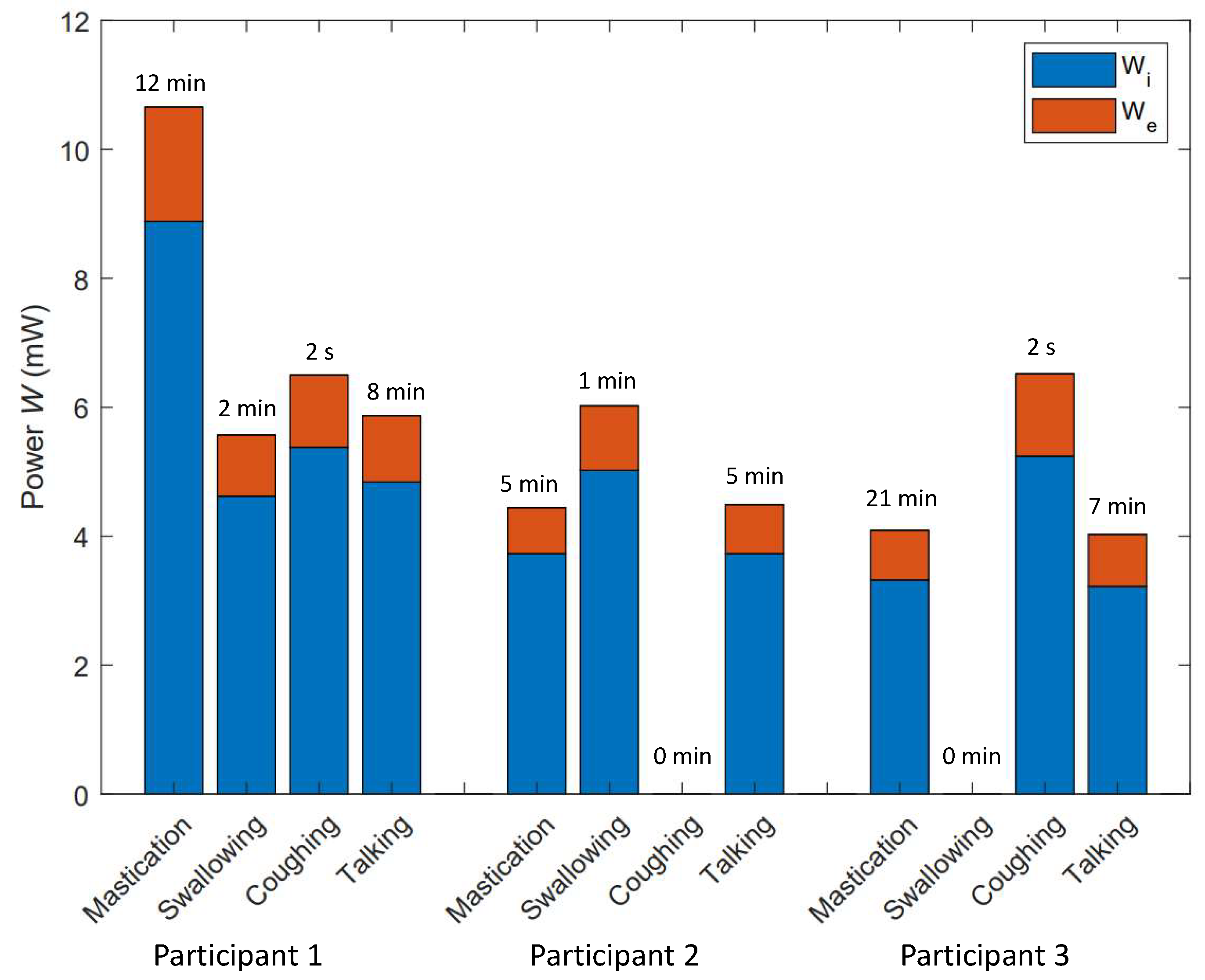1. Introduction
Battery technology appears to be the slowest evolving feature in hearing aids. While hearing aids are becoming more compact with better sound quality, and enhanced features, their power supply battery continues to occupy a high ratio of their total volume. Most hearing aids rely on electrochemical batteries to operate, which involves either replacing or recharging them periodically, resulting in limited energy autonomy and reduced comfort to users. A possibility to overcome these disadvantages is to harvest energy from the human body or the proximate environment.
Several types of hearing aids whose chargers are powered by alternative energy sources have already been developed. A methanol-based micro fuel cell has been used for the instant charging of hearing aid batteries [
1]. Moreover, solar-powered chargers help to make hearing aids more affordable to the consumer and less pollutant to the environment [
2]. However, these technologies have done nothing to improve the energy autonomy of hearing aids.
This is why alternative sources of energy must be found to replace batteries. The energy required to power hearing aids can be extracted from electromagnetic waves. It is estimated that a person who spends 1 h outdoors every day will be able to harvest an average power of
from ambient light and
from radio waves [
3] based on the most optimistic scenarios.
Body heat is another source of alternative energy for hearing aids. The human head could provide
–
W of power in an optimal energy conversion situation [
4]. A thermoelectric generator and its associated electronic circuits have been tested in the area around the ear [
5], but the practicality, comfort and efficacy of such systems are relatively limited given that an array of generators and consequently more skin surface are eventually required to obtain the necessary amount of power.
Ear-centered energy sources for hearing aids are more interesting for obvious reasons. Take for instance the Endocochlear Potential (EP) that is created due to a difference in the number of potassium ions (charged atoms) on either side of a membrane deep in the inner ear [
6]. Findings show that this kind of biological battery could harvest around 1 nW from the cochlea of a guinea pig for up to 5 h. Another ear-centered energy source is the dynamic movement of the earcanal. The jawbone is connected to the skull by the Temporomandibular Joint (TMJ), which is anatomically located very close to the earcanal near its first bend. Consequently, jaw movements deform the earcanal, causing what is called earcanal dynamic movements.
Earcanal dynamic movements have been studied for several reasons by researchers. In particular, audiologists are seeking to enhance the comfort of hearing aids and solve their associated retention problems [
7,
8,
9]. Indeed, the magnitude of the canal’s widening should be correctly quantified by clinicians during patient examination based on the earmolds taken at two extreme jaw positions: wide open and closed, to correctly select an impression material and decide whether or not taking an open mouth impression is justified [
10]. Moreover, earcanal dynamic movements have been investigated for sensory applications. An earcanal bending sensor consisting of a thin piezoelectric strip attached to a custom-fitted earpiece has been developed to estimate the average bending moment and the resulting stress applied to a custom-fitted earpiece while opening the mouth [
11]. Furthermore, a set of infrared proximity sensors has been utilized to measure the earcanal dynamic movements for different applications that require jaw activity tracking, such as silent speech recognition, jaw gesture detection and food intake monitoring [
12].
The idea of energy harvesting from earcanal dynamic movements was first presented by the authors in 2013 [
13]. Two different mechanisms (electromagnetic and piezoelectric) were proposed to harvest energy associated with such movements. The prototypes were tested for a single test subject. Based on the results, the energy capability of the earcanal was subsequently roughly evaluated for 12 test subjects based on the extent of their earcanal deformations [
14]. The earcanal dynamic movements were later investigated more extensively by either COMSOL (Stockholm, Sweden) multiphysics finite element modeling [
15] or analytical modeling [
16] to evaluate the energy capability of the earcanal dynamic movements. A more recent study on a wearable power sensing device developed to measure the power associated with earcanal dynamic movements [
17] shows that a mean power of
mW is readily available on average for a single earcanal, based on a test in which 6 subjects chewed a meal for a period of several minutes. However, the paper does not provide information about the energy capability of the earcanal dynamic movements for other jaw joint activity nor on the long-term energy evaluation tests.
This paper aims to calculate the energy capability of the main jaw joint activities, namely mastication, swallowing, coughing and talking during a 3-h earcanal dynamic evaluation test for three test subjects. The in-ear power sensor equipped with an earphone to detect jaw joint activity is presented in the next section.
Section 3 and
Section 4 discuss details to calculate the power and detect and classify the jaw joint activity using the developed in-ear power sensor. Tests and measurements are presented in
Section 5 followed by results and discussions in
Section 6. Finally, the conclusions are drawn in
Section 7.
2. In-Ear Power Sensor
The mobile in-ear power sensor device is composed of a pair of earmuffs; that is, a headband that fits over the head supporting two instrumented cups at each end. The right cup consists of a pre-installed inflatable earplug with three levels of earcanal penetration: short, medium and long. The earplug is inflated with water using a hydraulic circuit including tubes, valves and a pressure sensor, all fitted inside the right cup as shown in
Figure 1. This cup also contains electronic circuits for pressure signal conditioning, amplification and data transfer. Water is injected into the hydraulic circuit using a syringe, through the input check valve and the signals are transmitted to the data acquisition and recording system through wires coming out of the cup.
The left cup is equipped with an earphone with two miniature microphones: In-Ear Microphone (IEM) and Outer Ear Microphone (OEM) as shown in
Figure 2. The earphone is fitted into the earcanal using a generic foam earpiece called EARTIP (Comply, Oakdale, MN, USA).
The Auditory Research Platform (ARP 3.0) and its associated data acquisition system developed in the authors’ laboratory (CRITIAS, Montréal, QC, Canada) are used for both audio and pressure signal acquisition. The ARP uses a tactile screen and Windows operating system and is placed inside a waist bag carried by the subject during the test as shown in
Figure 3. A rechargeable battery is also placed in the bag to power the pressure sensor and the analog front-end by a wire running to the earcup.
3. Jaw Joint Power Calculations
The total energy of the liquid-filled earplug inside the earcanal can be calculated by the following energy equation
in which the first term is the internal energy (
) of the water at pressure
P and total volume
V, and the second term is the elastic potential energy stored in the expandable earplug membrane and the deformable earcanal wall with the equivalent stiffness
and the total deformation
U measured with respect to a reference position
. Upon jaw joint activity, the kinetic energy of the earcanal movement is transferred to the internal pressure energy of the water and the elastic deformation of the earcanal–earplug system. By assuming that the water is incompressible (
) and ignoring the energy loss due to dry friction, viscous damping or heat dissipation, the instantaneous power can be calculated by the time derivation of the energy equation, whereby
The pressure variation d
P is measured by the pressure sensor and the equivalent stiffness
k of the combined earplug and earcanal system is experimentally measured for each test subject by measuring the rate of the pressure change (measured by the pressure sensor) with respect to the volume change of the earplug (measured by the syringe with precise volume markings) as the earplug inside the subject’s earcanal is being filled. Therefore,
The total energy
E during the time interval
is calculated by integrating (
3) over the time period, as
Finally, the average power generated by the earcanal’s dynamic movements during the test
is estimated by dividing the total energy from Equation (
4) by the duration of the test,
, shown as
6. Results and Discussion
The pressure–volume diagram of the earplug as it is being filled while inside the test subject’s earcanal is illustrated in
Figure 4. This graph can be used to determine the rigidity
k of the earplug–earcanal system by calculating the tangent of the curve at the working pressure of 14 kPa.
The audio and pressure signals measured for one test subject are shown in
Figure 5. This figure also includes the instantaneous power computed using Equation (
3). Two dense areas of pressure variations can be identified in
Figure 5b which result in two high power regions around 4000 s and 9000 s in diagram (c). Correspondingly, the audio activity can be evaluated as high around 4000 s and low around 9000 s as depicted in diagram (a). Therefore, it is quite reasonable to assume that the first high mandibular activity region is associated with continuous talking while the second is related to eating which is normally more quiet than talking. This assumption can be validated by listening to the audio signal. However, given the long duration of the tests and the number of test subjects, a listening-based interpretation of the audio signals would be very time consuming.
Therefore, the results are fully investigated by programming the jaw activity detection algorithm based on the audio signals. For each activity detected by the algorithm, an identifier is given to the time axis to mark the time interval at which the detected verbal and non-verbal events happen. Then the corresponding power signal is segmented based on the defined identifiers and the segments are regrouped into five categories: (1) chewing (2) swallowing, (3) coughing, (4) talking and (5) no activity. The detailed results for one test subject are shown in
Figure 6.
According to
Figure 6, the variation of the calculated power associated with chewing is quite consistent given the regular rhythm of chewing that a person normally maintains while eating. The power associated with talking is more volatile depending on the uttered words, speaking pace and voice loudness. Swallowing exhibits more discrete power regions due to its low frequency profile. Finally, the power diagram for coughing shows more distinct and isolated peaks due to its spontaneous occurrence.
A high instantaneous power peak does not necessarily mean that the corresponding jaw activity has the greatest potential for energy harvesting. For example the coughing event seen in
Figure 6 can generate more than
at its maximum peak, which is much higher than the maximum power peak for the chewing event. However, coughing happens sporadically and lasts less than a second, while chewing is continuous and lasts several minutes. Therefore, the segmented power diagrams are subsequently used in Equation (
4) to obtain the total energy and eventually Equation (
5) is used to calculate the mean power associated with each jaw joint activity. The mean power generated by the internal pressure (
) and elastic deformation (
) components as well as the duration of each jaw movement-related event are reported in
Figure 7 for all test subjects.
As shown in
Figure 7, chewing has the longest lasting sequence among the test subjects with the duration varying from 5 to 21 min. Talking comes in second place with a duration of less than 8 min for all test subjects. Coughing comes in last, as it only lasts a couple of seconds. The classification of the mean power among test subjects is quite varied. While chewing has the greatest mean value for subject 1, swallowing and coughing generate more power on average for subjects 2 and 3. Nonetheless, the grand winner of the maximum energy potential (the multiplication of the mean power and duration) is chewing (except for subject 2, for whom talking generates as much energy as chewing).
A summary of the results, parameters and variables used in the paper to calculate the energy potential and power generation for each test subject is listed in
Table 2. This table presents the water volume
V, and the equivalent rigidity
k taken into consideration in Equation (
3) to calculate the instantaneous power. In addition, the total duration of the test
, the total energy potential
E and the calculated mean power
are presented for each test subject separately in this table. The table also includes
R, which represents the time ratio at which the jaw joint is active. The mean value of
R is 13%, which means that the jaw bone was stationary and inactive for most of the time. Gum chewers and talkative people are likely to have higher jaw activity time ratios and hence more potential to generate in-ear energy. In addition, according to the results,
mW of power on average are expected to be available from earcanal dynamic movements, which is about 4 times greater than the power needed to run typical hearing aids.
